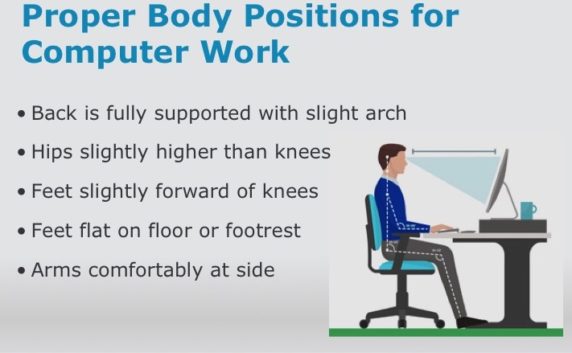<< Back
Going Back to Office With Work-From-Home Pain? A Physical Therapist’s Tips

May 13, 2021
When much of America pivoted to working from home in March 2020 as COVID-19 surged across the nation, spur-of-the-moment set-ups for laptops and office supplies spread around the house to kitchen tables, card tables, coffee tables and couches.
As work-from-home became the routine, some people invested in actual office equipment and carved out a space for themselves in the house. Others remained hunched over the laptop on the sectional morning, noon and night.
Across the country, aching backs, necks and shoulders brought on by COVID-19-related lifestyle changes have sent many people to physical therapists — a trend likely to continue. Besides issues related to work-from-home set-ups, people are also getting injured from new exercise routines because their regular gyms closed, or they no longer want to go to them.
 Like many healthcare providers, physical therapists saw patient visits drop dramatically when the pandemic started. During those early months, 54 percent of physical therapists said they were working fewer hours, according to an American Physical Therapy Association survey.
Like many healthcare providers, physical therapists saw patient visits drop dramatically when the pandemic started. During those early months, 54 percent of physical therapists said they were working fewer hours, according to an American Physical Therapy Association survey.
Physical therapist Lee Bennett, site supervisor for Hartford HealthCare’s Pawcatuck HealthCenter, is seeing patients who either suffer from new issues because of working from home or have flare-ups from old injuries.
“Some patients are presenting with history of back or neck pain that started to get worse as they started working from home,” he said. “Some of these patients were aware that their issues are related to their home workstation set up, and others were unaware until we saw them for their evaluation.”
Bennett said the most common issues he’s seeing are neck, back, elbow and wrist pain. He noted that some patients were also having secondary issues because of higher rates of inactivity, as in, they were sitting at their desks for hours and hours with no breaks.
The three biggest troublemakers for working from home, Bennett said, are sitting for too long, not sitting in a supportive chair, and working from a laptop instead of a desktop computer, which puts additional strain on the neck.

Bennett had some tips for a healthy work-from-home set-up, as it appears many people may continue doing so for some time:
- Find a chair that allows you to sit against the back of it with feet rested flat on the floor to allow better support.
- Have your workstation on a table or desk at a comfortable height to allow your elbows to hang at your side while using the keyboard.
- Items that you use the most should be placed in an area that minimizes your need to lean forward or twist to retrieve.
- Attempt to take planned breaks. Stand up, even briefly, at least every 30-60 minutes.
- Perform regular stretches or range-of-motion activities for your neck, arms and hands while at your workstation or when you take your planned breaks.
- It is also helpful to occasionally look at objects farther away from your screen, to allow your eyes to have a break from looking closely at a screen.
The Hartford HealthCare HealthCenter at 350 Liberty St. in Pawcatuck offers easy access to primary care, pediatric and adolescent primary care, and rehabilitation services for patients in southeastern Connecticut and Western Rhode Island. For more information, click here.